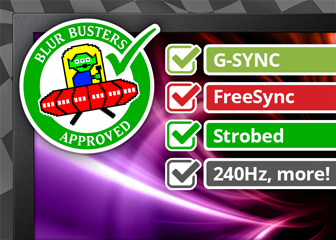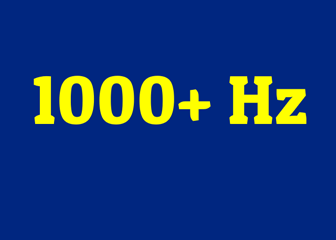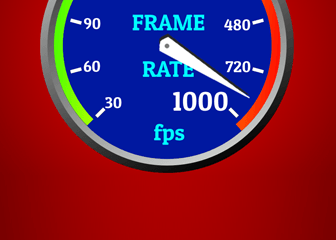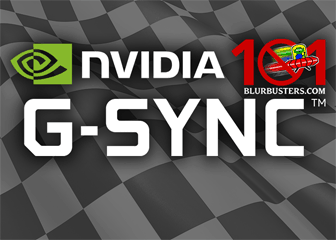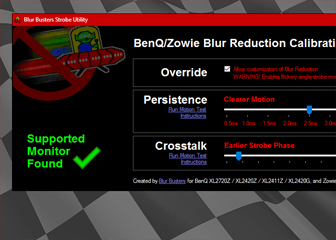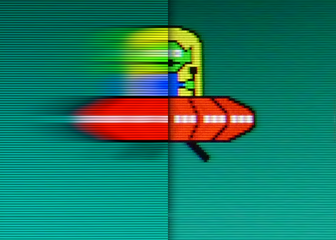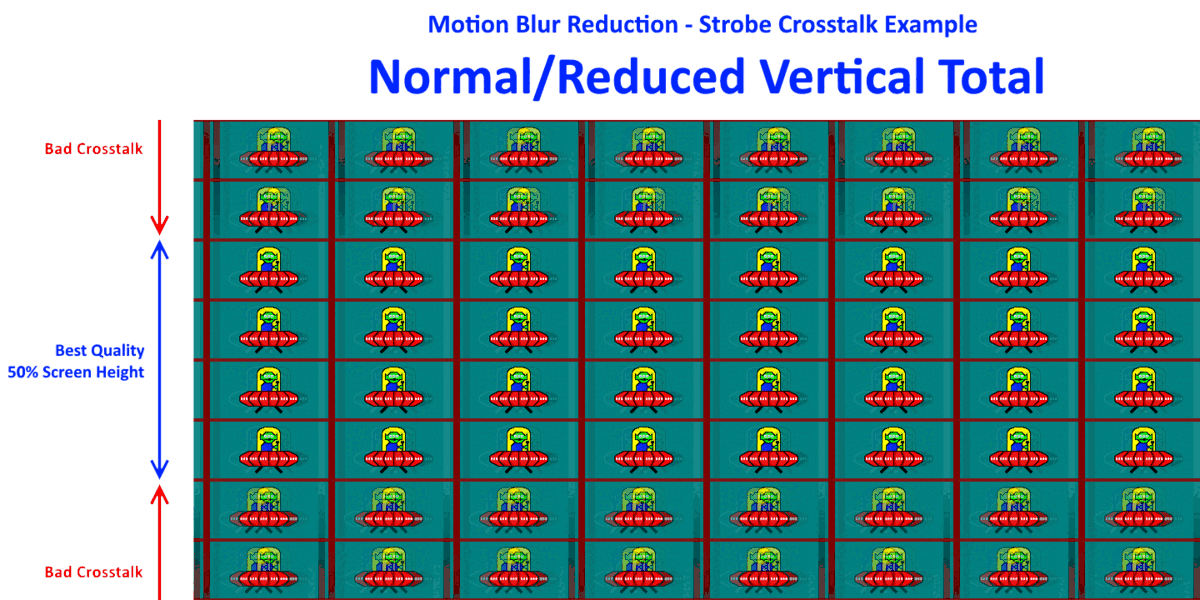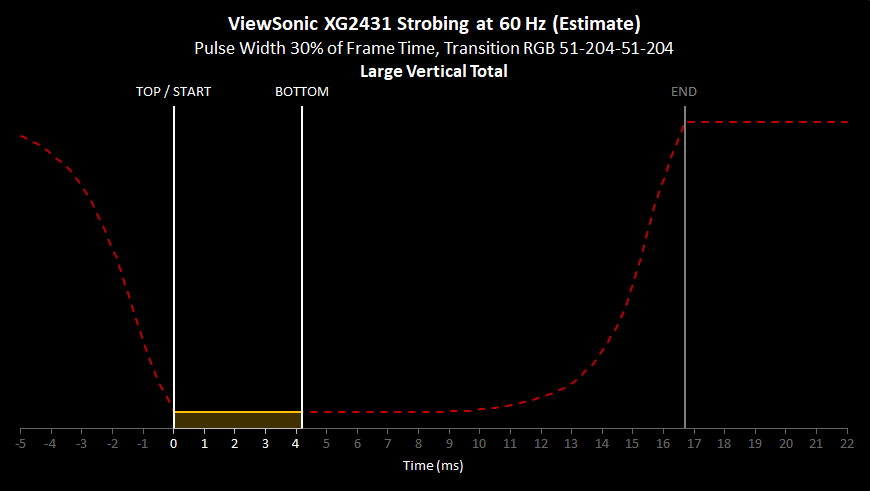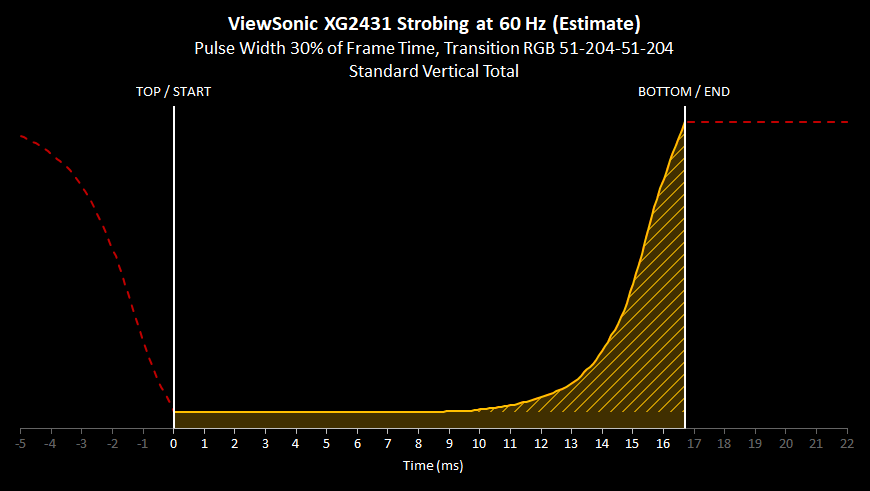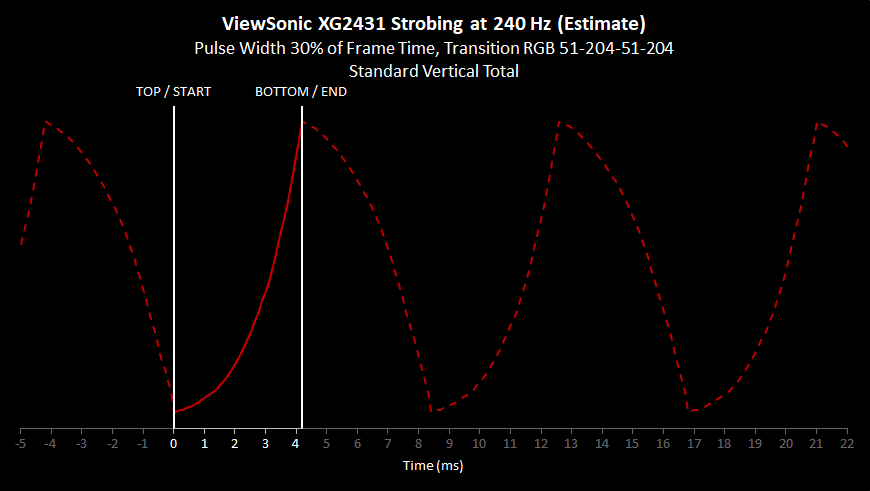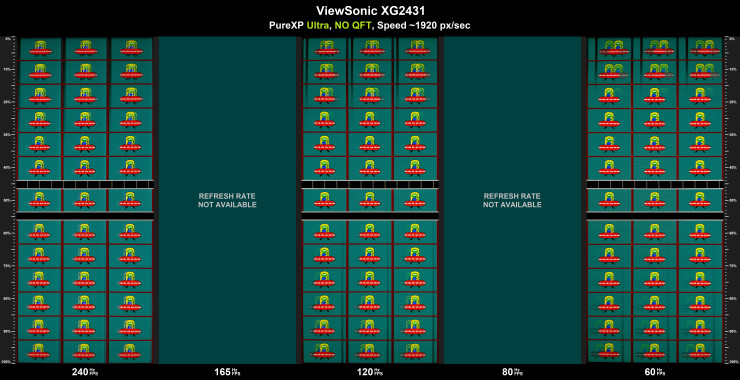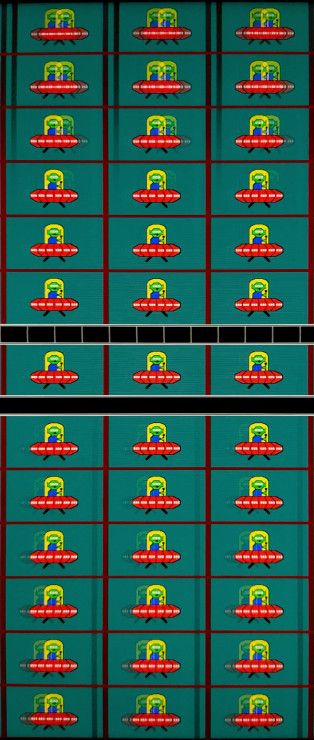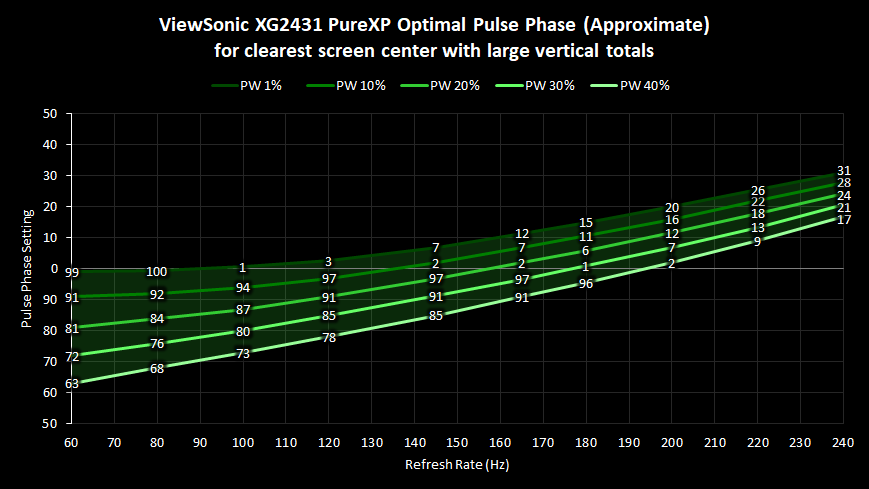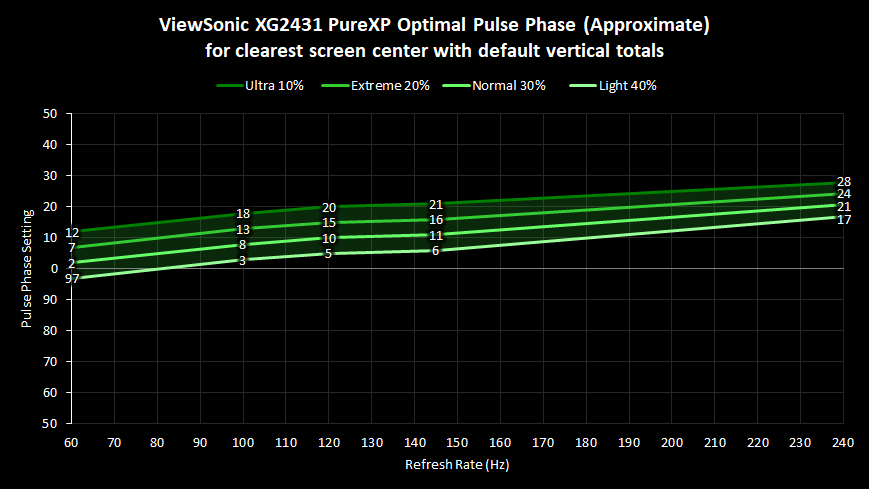Most manufacturers would stop strobe tuning here, but there is a way to improve top-bottom crosstalk, in some cases significantly. Blur Busters highly recommends using Large Vertical Totals or large Vertical Blanking Interval (VBI), also known as Quick Frame Transport (QFT) or Fast VActive (FVA). Vertical Blanking Interval is additional time between refresh cycles that allows the two to synchronize. Essentially, computers are outputting a bigger signal to allow synchronization intervals and porches, and screen is only displaying the center of that bigger signal (see video signal structure).
There are two benefits to QFT:
- it reduces strobe crosstalk and
- simultaneously reduces latency for low refresh rates.
Same can be said for sample & hold modes, only instead of strobe crosstalk it reduces scan-out skew/jelly effect.
If you are familiar with how Variable Refresh Rate (VRR) works you’ll have easier time understanding QFT as they work on similar principle – In order to synchronize to varying frame rate/frame times, VBI part of the signal is shrinking/expanding without affecting the initial scan-down speed. Outside VRR, VBI size is simply fixed and not changing. By making a custom resolution with fixed enlarged VBI (vertical total) we can keep panel’ maximum scan-out velocity, therefore boost up the scan-out.
In terms of frame delivery, QFT 60 Hz is equal to VRR 60 fps at 240 Hz. For example, during QFT 60 Hz screen will scan down at 240 Hz speed, the rest of blank time it holds the drawn image:
- Standard VT 60 Hz: …(VBI 0 ms + scan-out 16.7 ms = 16.7 ms) + (repeat)…
see high speed video - Large VT 60 Hz: …(VBI 12.5 ms + scan-out 4.2 ms = 16.7 ms) + (repeat)…
see high speed video of 165 Hz velocity

Scan-out comparison between standard 60 Hz vs QFT 60 Hz (at 240 Hz velocity) vs standard 240 Hz, transition RGB 51-204-51-204, GtG = 0 ms
This essentially means we need to reduce the refresh rate to utilize QFT. On XG2431 vertical totals at maximum refresh rate are already maxed out and no real crosstalk improvements can be done. PureXP presets are already well tuned at 240 Hz so there may be no need for Strobe Utility, unless one needs finer brightness/MPRT adjustment or wants to adjust for lower lag phase. To further improve 240 Hz we would need much larger refresh rate headroom. However even a 1000 Hz panel would only give us 3.2 ms of headroom for GtG to settle.
Chief wrote:
With QFT active, the scan-out is faster (e.g. at 60Hz VT4500 top-to-bottom sweeps out in 1/240sec = 4.2ms). That means more idle time between refresh cycles which gives LCD GtG more time to finish settling or more time to flash a backlight clearly. That is precisely why there’s less strobe crosstalk with QFT.
Chief wrote:
The height of “VBI” in the scanout diagrams needs to be taller than the “GtG Zone”! This is how a monitor can hide strobe crosstalk between refresh cycles – timing the strobe backlight in a way to move the crosstalk band off the bottom edge of the screen long before it reappears at the top edge of the screen.
Crosstalk – Large Vertical Totals (QFT) vs Standard
The difference between QFT and non-QFT can be quite drastic. At 60 Hz without QFT, we achieved around 50% crosstalk-free area. With QFT, this increased to 100%, eliminating top and bottom pre/afterimages completely. As refresh rate increases and frame times shorten, QFT’s impact diminishes. At 120 Hz we went from roughly 25% to about 50%. Some faint ghosting remains visible, but it is still very tolerable. Beyond 120 Hz, QFT’s benefits continue to taper off. Once we reach 240 Hz, scan-out speed is maxed out, so QFT offers no further gain, leaving the crosstalk-free area at 0%. Keep in mind that these pursuit images were taken at 10% pulse. Longer flash durations capture more of the GtG, which in turn exposes more crosstalk.
We have learned that to improve crosstalk we can:
- Speed up GtG with overdrive to mitigate pre/afterimages.
- Work around GtG or backlight limitations by giving it more time to flash frames more clearly. In conjunction with pushing the crosstalk band offscreen (optimal pulse phase) this includes:
• reducing refresh rate,
• using faster scan-out (QFT at reduced refresh rate),
• using shorter pulse widths.
Faster refresh rate can help squash the crosstalk too – the faster the scan-out, the smaller the time difference between backlight and scan-out. But since GtG speed is insufficient for narrow refresh windows, afterimages become more visible. This shows very well on pursuit images.
Don’t forget that GtG is not main cause of crosstalk! Even with instantaneous pixel response there would still be some crosstalk at the top and bottom because of the immobile backlight vs mobile scan-out issue. We would still need some QFT to work around the artifacts. At maximum refresh rate crosstalk is much harder to get rid of.
One way industry could solve this issue is with a type of scanning backlight (segmented, FALD MiniLED), but at the moment zone count is insufficient, light leakage is hard to control and they’re inflexible and sometimes laggy. While being dim, OLEDs would’ve been perfect in this regard (LG C1/CX) as each pixel is its own light source. Unfortunately panel manufacturers removed the rolling BFI feature from their new OLEDs, which is a big loss for BFI fans. But don’t lose hope! We are starting to see manufacturers experiment with new solutions. Zowie, Asus and AOC have recently introduced a new technology which tries to eliminate the top-bottom crosstalk by rolling the edge lights.
How to Quick Frame Transport (QFT)
Out-of-the-box XG2431 comes without QFT resolutions, hence you’ll need to make them yourself. Custom resolutions can be made in Nvidia control panel and AMD settings but I have not tested those. We’ll stick with ToastyX Custom Resolution Utility (CRU) for now as it comes with a very neat “Vertical Total Calculator” intended for exactly this purpose.
To avoid conflicting resolutions (e.g. there are three 1080p 60Hz resolutions by default), it’s recommended to remove all excess resolutions beforehand, except max Hz as we will derive the timings from it (see video description).
While testing I encountered a few limitations. By increasing vertical totals, clock speeds are getting larger too. XG2431 is capable of going up to 600 MHz on both DisplayPort and HDMI inputs. To get maximum out of it, I Initially expected VT could be increased until clock limits were reached. However anything above ~568.5 MHz had a countereffect – even though panel accepted signals up to 600 MHz, crosstalk above ~568.5 MHz appeared to be the same as with standard/reduced VT.
There are more side effects such as blackouts, black screen, VRR overdrive bug, but they highly depend on which refresh rate, gpu and input you’re using (see more limitations I encountered here). In the end I settled with resolutions simply derived from factory 240 Hz, which were most easy to create thanks to vertical total calculator.
60 Hz on DisplayPort derived from factory 240 Hz was unstable and requires VT to be reduced manually to work. HDMI may be more stable in that case. To manually reduce Vertical Total simply switch the “Timing” to “Manual” and enter custom value. On some gpus I was able to get VT 4625, while on others 4500. Some users reported they had to reduce it further to ~4200.
Most monitors allow vertical totals tweaks, but by changing VTs we affect display scan-out, therefore crosstalk band will shift and timing of the pulse will need to be repositioned. For monitors lacking a multi-level strobe phase setting, QFT might not look the best (unless it’s automated). Nonetheless, sample & hold modes are not affected by phase so we still gain the latency benefit. Pulse phase is a rare feature to see on monitors, but recently we’re seeing manufacturers like Asus starting to implement a “clarity position” setting. Even some of the new Nvidia ULMB 2 monitors now offer a “pulse offset” setting.
For PureXP Light, Normal, Extreme and Ultra presets, Pulse Phase and Overdrive Gain are automated to optimal for any custom standard/non-QFT resolution or refresh rate, which is nice. However using existing presets with QFT resolutions should be avoided as it will apply far from optimal phase setting. You will want to switch to PureXP Custom to fix that.
Optimal Pulse Phase setting highly depends on:
- Refresh Rate,
- Vertical Total,
- Pulse Width,
- GtG.
Changing any of the variables will shift crosstalk up/down the screen so each time you’ll need to re-evaluate or readjust to your optimal values that you have hopefully written down somewhere, because unfortunately Strobe Utility does not feature saving presets. It only memorizes the last modification done to Custom preset. Quite impractical!
After many tests and eyeballing, here are all the optimal phase settings graphed out.
You can find rest of the optimal settings listed in the spreadsheet bellow. I tested the range in ~20 Hz increment. In case you need settings for in-between refresh rates try linear regression with OneCompiler App (Credit to Elexor and Chief).


Why is QFT not automated?
Interestingly VRR (Variable Refresh Rate such as FreeSync and G-SYNC) is already a built-in QFT. However, manufacturers have never added QFT to fixed-Hz modes because QFT requires non-VESA timings.
Blur Busters wrote:
Manufacturers don’t pay for QFT, nor they pay for QFT tuning at this juncture…. Then the pandemic hit…They didn’t want to redesign their menu structure for automated QFT. Lots of communications between third parties are needed for that, and there’s often NDA firewalls between all of us, so it’s hard to communicate about unauthorized features not approved by management.
But the eureka breakthrough was convincing ViewSonic to enable the API (the API that Strobe Utility uses)….which meant we could transfer responsibility to the end user…Letting users DIY was still a win.
CRU is a PC program that creates software EDID overrides in the registry and does not modify the hardware, meaning QFT mod won’t work for consoles. Using just Strobe Utility features would be problematic as well. Although I haven’t tested, I assume all the modifications need to done on PC first, and then switch back to the console. Changing refresh rates would mean users need to reconnect back to PC to adjust the utility and switch back to console. Another impracticality! However, presets are always available in OSD.
If parameters were automated for QFT, even consoles could benefit.
